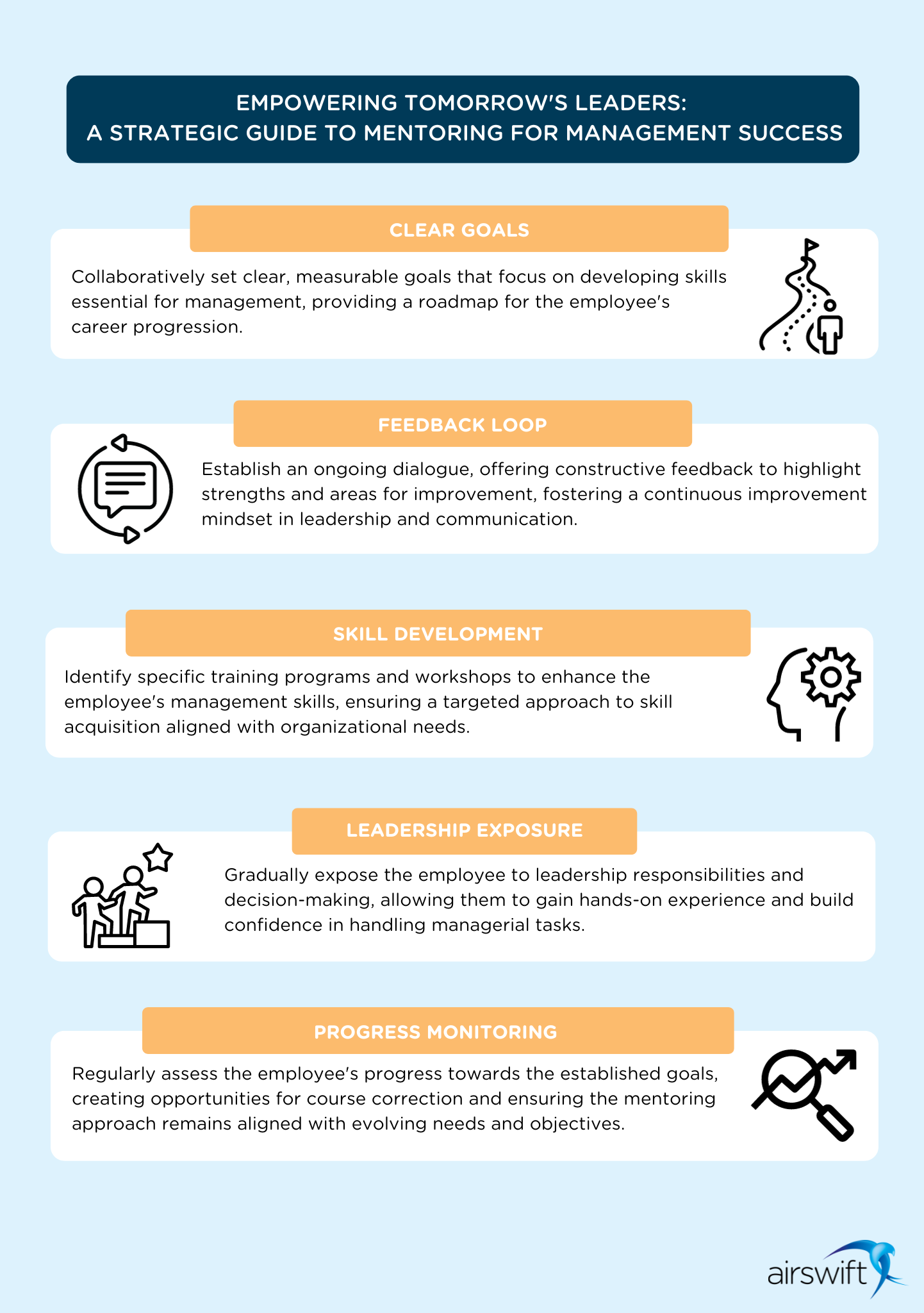
By
Diyaa Mani
January 5, 2024
Updated
September 18, 2024
In today's fast-paced landscape, ambitious employees yearn to take on leadership roles.
Moving from team member to team leader isn't always easy, despite the appeal of more responsibility and career advancement. Often, a gap separates the desire for leadership and the skills required to excel. But here's the flip side: we should not dread this gap but rather build it as a bridge.
Investing in the right strategies and empowering employees can turn this challenge into a growth opportunity. It reduces frustration and turnover while creating strong, inspiring leaders.
This article unlocks the secrets to navigating this transition. It equips you with strategies and insights to empower employees in their leadership journey:
Navigating the management gap
Aspiring managers often face a double-edged sword: the drive to lead and the gap between their current skill and leadership demands. Without key skills like problem-solving, planning, and effective communication, they may struggle to collaborate and achieve goals. Important experiences like working on different projects or leading a team may not be on their resumes. Yet.
But the challenge is not always one-sided. Organisations, too, face their share of roadblocks. Some lack structured development programs, leaving talented employees to navigate their growth in a vacuum. Others might have programs, but ineffective implementation or limited scope can leave their leadership pipeline untapped.
This is where the pursuit of personal growth and organisational health converges. Organisations help employees reach their full potential by investing in programs that fill skill gaps and offer relevant experiences.
For individuals, honing leadership skills unlocks career advancement and personal satisfaction. For organisations, it cultivates a robust bench of future leaders, boosting efficiency, team performance, and their long-term success. Focus on growth to become a leader or improve leadership within your organisation. You should direct this growth towards both internal and external aspects.

Filling the employee skills gap with a management development program
A powerful management development program works best as part of a broader strategic framework. Creating a culture that values learning and growth, with clear career paths and mentorship opportunities, helps develop strong leaders.
Google's "Associate Product Manager (APM)" initiative is a notable example of a successful management development program. Google focuses on a combination of mentorship, specialised training modules, and hands-on project work to groom future leaders. The APM program imparts technical skills and strongly emphasises soft skills and leadership qualities. Google's commitment to this method has led to the program's success, with numerous APM graduates progressing to leadership roles.
Similarly, Microsoft's "LEAP" program is another compelling case study. LEAP, or the Leadership Excellence Acceleration Program, emphasises a mix of mentorship and tailored training modules. Microsoft places participants in challenging projects that demand cross-functional collaboration and strategic thinking.
The program's success is evident in the rapid career advancement of its participants. Many participants attribute their promotions and growth to LEAP.
These examples highlight the transformative power of well-designed management development programs. Organisations can help employees succeed in leadership roles by using a comprehensive approach that includes more than just training. This, in turn, leads to a more engaged workforce, higher performance, and a sustainable competitive advantage.

Understanding skill gaps and employee motivations
Understanding skill gaps and motivations is crucial for maximising potential and ensuring smooth transitions. Skill gaps can hinder managers, while different motivations drive employees to seek these roles.
Let us delve deeper into these key aspects:
1. Identifying the gap
Employees aspiring to management roles may lack critical skills such as leadership, communication, performance management, project execution, and financial literacy.
Recognising and addressing these gaps is pivotal for successful management transitions. Consider emotional intelligence, adaptability, and conflict resolution as crucial aspects of leadership. Effective communication encompasses active listening, empathy, and tailoring messages to diverse audiences.
Performance management thrives on constructive feedback, achievable goals, and recognising individual strengths and weaknesses. Building strong organisational skills, risk assessment, and effective delegation empowers project execution. Understanding basic financial concepts equips managers to make informed decisions.
Companies can bridge this gap by conducting skill assessments to identify gaps and tailor development plans accordingly. Encourage self-reflection and open communication about career aspirations.
2. Motivations for seeking management roles
Understanding the motivations behind employees aspiring to management roles is crucial. Motivations for leadership include wanting more responsibility, mentoring, shaping the organisation, and better career opportunities.
Beyond the thirst for increased responsibility and authority, consider diverse motivations. Some individuals seek to shape the organisation's direction and make a tangible impact. Others desire personal growth, new skills, and challenging responsibilities. Work-life balance can also motivate, as management positions may offer greater flexibility and control over schedules.
Offering diverse leadership development opportunities catering to different motivations can be beneficial in this case. Connect aspiring managers with experienced leaders who share similar values through mentorship programs.
.png?width=584&height=826&name=Copy%20of%20How%20are%20the%203%20Ps%20Of%20Sustainability%20related%20to%20ESG%20(1).png)
3. Skill and experience gaps
Leadership and strategic thinking, communication, performance management, project execution, and financial literacy are key gaps hindering successful management transitions.
To break down how to address the key skill gaps:
- Leadership and strategic thinking: Develop training programs on team building, decision-making, and strategic planning. Encourage cross-functional projects to broaden perspectives.
- Communication: Offer workshops on effective communication, active listening, and delivering constructive feedback. Utilise peer-to-peer feedback and role-playing exercises.
- Performance management: train managers to set smart goals, conduct effective performance reviews, and provide ongoing coaching and development. Offer access to online resources and best practices guides.
- Project execution: Project management training and certifications can equip aspiring managers with essential skills. Implement a buddy system where experienced managers mentor newcomers.
- Financial literacy: Organise workshops on relevant financial concepts. Encourage online courses and self-directed learning resources.
HR plays a significant role in monitoring and addressing the skills and experience gaps within the organisation. They can address this by conducting regular performance reviews for managers, focusing on leadership effectiveness and team outcomes.

4. Consequences of unprepared managers
Promoting unprepared employees to management can cause turnover, poor team performance, project failures, and harm company culture and reputation. Many potential ethical concerns can arise from financial illiteracy or poor performance management. Unprepared leaders can also hinder organisational innovation and adaptation to change.
Companies must implement ethics training and establish clear company policies to overcome this issue. Encouraging constant learning and innovative thinking helps employees improve their skills and prepare for new roles and challenges.
5. Alternative career paths for high-performing employees
Top employees who do not want to be managers have other career options. These options include specialising in a specific area, leading in technical areas, managing projects, and becoming trainers or mentors.
Encourage deep dives into specific technical areas, fostering subject matter experts who drive innovation. Create leadership tracks for technical specialists, allowing them to guide and mentor teams without formal management responsibilities. Invest in developing skilled project managers and offer career paths within this realm. Internal training programs and mentorship opportunities empower experienced individuals to share knowledge and expertise.
Companies can talk to high-performing employees about their career development. They can determine if these employees want to pursue a different career path. During these discussions, companies can also explore the goals of these employees.
Additionally, companies can present various job options to these employees. They can discuss their goals and show them different job options within the company.
Building the bridge between aspiring employees and a successful management career
An effective management development program is essential to prepare employees for leadership positions. Not only must it be comprehensive and adaptable, it should focus on nurturing employees' capabilities and leadership potential.
It should lay a strong foundation built on key components that are tailored to address different aspects of managerial responsibilities. This ensures that emerging leaders are well-rounded, prepared for challenges, and capable of guiding teams to success.
Key components for a successful managerial program
1. Mentorship and coaching
Pairing experienced managers with aspiring employees provides personalised guidance and support. Through open and honest dialogue, mentors can inspire mentees to unlock their full potential and confidently navigate leadership challenges. This one-on-one interaction fosters trust and builds a sturdy foundation for leadership development.
2. Training and workshops
Employ focused training sessions on essential leadership skills such as communication, delegation, performance management, and conflict resolution to prepare employees for effective management. Interactive simulations and case studies help future leaders learn and apply important skills in a safe setting.
3. Cross-functional exposure
Giving employees chances to learn about different company departments helps them understand the organisation better. It also allows them to broaden their perspective and establish connections with individuals from different departments.
This fosters a culture of inclusivity and mutual understanding within the organisation. This creates a culture of inclusivity and understanding in the organisation.
4. Project-based learning
Employees gain skills, become leaders, showcase abilities, and learn from experienced mentors through real-world projects. These projects provide employees with valuable opportunities to apply their skills and develop their leadership abilities. Additionally, employees can demonstrate their capabilities and gain practical experience under the guidance of experienced mentors.
5. Self-assessment and feedback
Providing employees with tools and resources helps them identify their strengths and weaknesses. It also enables them to set goals, receive feedback, and reflect on their performance. These actions contribute to continuous improvement.
Encouraging self-reflection and providing constructive feedback in a supportive environment fosters continuous growth and empowers employees to take ownership of their development.
Tailoring the program
Flexibility and adaptability are key to the program's success. The program needs to cater to individual needs and career goals. It offers personalised learning plans, options for focus areas and training modules, and various learning formats.
Leadership's role
Creating a supportive environment is crucial for the program's success. Leadership can champion the program, encourage active participation, celebrate achievements, and allocate resources to ensure sustainability.
Building a strong leadership pipeline
Investing in the development of employees enables organisations to build a strong pipeline of qualified and prepared leaders. This leads to higher engagement, improved team performance, a positive work environment, and a competitive edge in the marketplace.

How companies cultivate leadership: Strategies for effective management transitions
Bridging the gap from aspiring leaders to competent managers requires individual initiative and unwavering support from the company. Here, we explore organisations' crucial role in fostering successful management transitions through various initiatives and a nurturing environment:
1. Actively promote and champion the development of employees
Company leaders must champion and recognise their employees as an investment in future organisational success. Effective leadership development starts at the top.
Company leaders should actively support employee growth. They can do this by participating in mentoring programs, showcasing successful transitions, and integrating leadership development into strategic planning. This demonstrates a genuine commitment to building a strong future workforce.
2. Encourage managers to identify and nurture potential leadership qualities
The onus of leadership development should not solely fall on employees. Managers play a crucial role in identifying and nurturing potential within their teams. This means actively creating opportunities for leadership practice, providing constructive feedback, delegating challenging tasks, and offering mentorship beyond technical skills. It is about shaping well-rounded leaders who can inspire and motivate others.
3. Allocating sufficient financial and resource support
To make the program successful, you may need to hire experts, give them the right tools, and give them challenging tasks. Building a robust management development program requires more than simply good intentions. Organisations must be willing to invest financially in skilled facilitators, training materials, innovative technology, and leadership workshops. Providing access to necessary resources, like leadership assessments and development tools, empowers employees to take ownership of their growth.
4. Offering carefully curated stretch assignments
Stretch assignments are challenging tasks or projects that help employees develop leadership skills. This concept involves employees applying their skills in real-world scenarios, enhancing visibility, boosting confidence, and contributing significantly to their professional growth. Learning by doing, with curated assignments, helps employees apply skills in real-world situations, increasing visibility, confidence, and leadership development.
Learning by doing is a powerful tool for leadership development. This could involve heading cross-functional projects, leading client presentations, or taking on temporary management roles.
Stepping out of your comfort zone helps you gain confidence. It also helps you discover your potential. Additionally, it allows you to learn from both your successes and failures. All of this happens in a safe environment.
5. Establishing clear and transparent promotion processes
Promotions should be fair, with clear goals and communication about career options to inspire motivation and focus. A clear and meritocratic promotion process based on objective assessments is a compass for aspiring leaders. Clear career paths and promotion criteria inspire employees to invest in their growth and encourage healthy competition. Regular performance reviews with actionable feedback become critical touchpoints along the journey, ensuring everyone understands the milestones needed for advancement.
6. Cultivate a supportive organisational culture
A supportive culture forms the bedrock for smooth management transitions. It starts by valuing individual contributions, celebrating successes, inspiring confidence, and motivating growth. Open communication fosters learning and feedback, while strong leadership by example sets a model for future managers.
This supportive environment helps employees become better leaders by taking on challenges and leaving their comfort zones. Organisations need to create a supportive culture. This culture fosters an environment where leadership potential can grow. As a result, organisations ensure a strong pool of capable future managers.
A good management development program can effectively bridge the gap between employee aspirations and management skills. Investing in employees leads to better organisational leadership, engagement, performance, and a competitive advantage.

Airswift Employer of Record: Bridging the global leadership gap
Investing in your people's growth is not just the right thing; it is smart. At Airswift, we do more than just traditional workforce solutions. We help your team reach their full potential, improve performance, and gain a competitive edge in today's market.
Airswift connects top talent with organisations, ensuring you have the right people with the right skills in the right places. We offer a wide range of services for your industry, including talent acquisition, workforce consulting, and project workforce solutions.
Airswift's Employer of Record Services are your trusted partner in building a future of global leadership excellence. We can help you create and implement programs that unite people from different countries. These programs will empower your employees and help your organisation achieve a global future. Contact us today and unleash the leadership potential within your global workforce.
Ready to unlock the full potential of your workforce? Contact us today to discover how Airswift can tailor innovative solutions to drive your success. Click here to contact our team and embark on a transformative journey for your workforce.
